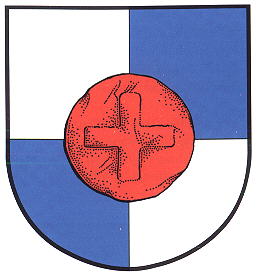Kosel: Difference between revisions
Jump to navigation
Jump to search
Knorrepoes (talk | contribs) m (Text replacement - "/Arms of " to "/Arms (crest) of ") |
Knorrepoes (talk | contribs) m (Text replacement - "{{media}}" to " {{de1}} {{media1}}") |
||
| Line 27: | Line 27: | ||
In the middle of the shield a red stone with a cross is placed. This stone can be seen on the main gate of the church in Kosel. As the church was the main church in the area, it was chosen as a central symbol. The cross again symbolises the four villages. | In the middle of the shield a red stone with a cross is placed. This stone can be seen on the main gate of the church in Kosel. As the church was the main church in the area, it was chosen as a central symbol. The cross again symbolises the four villages. | ||
{{ | |||
{{de1}} | |||
{{media1}} | |||
[[Civic Heraldry Literature - Germany|'''Literature''']]: Reissmann, 1997 | [[Civic Heraldry Literature - Germany|'''Literature''']]: Reissmann, 1997 | ||
Revision as of 11:31, 26 December 2022
This page is part of the German heraldry portal Deutsche Wappensammlung |
Heraldry of the World |
|
German heraldry:
|
Selected collector's items from Germany:
|
KOSEL
State : Schleswig-Holstein
District (Kreis) : Rendsburg-Eckernförde
Additions : 1977 Bohnert
Amt : Amt Schlei-Ostsee (until 2008 Amt Schlei)
| German | Von Silber und Blau quadriert, in der Mitte überdeckt mit einem natürlich strukturierten, flachen roten Stein mit rundem Umriss, der die Zeichnung eines griechischen Kreuzes aufweist. |
| English | No blazon/translation known. Please click here to send your (heraldic !) blazon or translation |
Origin/meaning
The arms were granted on February 2, 1989.
The quartered shield symbolises the four villages in the municipality; Bohnert, Kosel, Missunde and Weseby.
In the middle of the shield a red stone with a cross is placed. This stone can be seen on the main gate of the church in Kosel. As the church was the main church in the area, it was chosen as a central symbol. The cross again symbolises the four villages.
Literature: Reissmann, 1997


